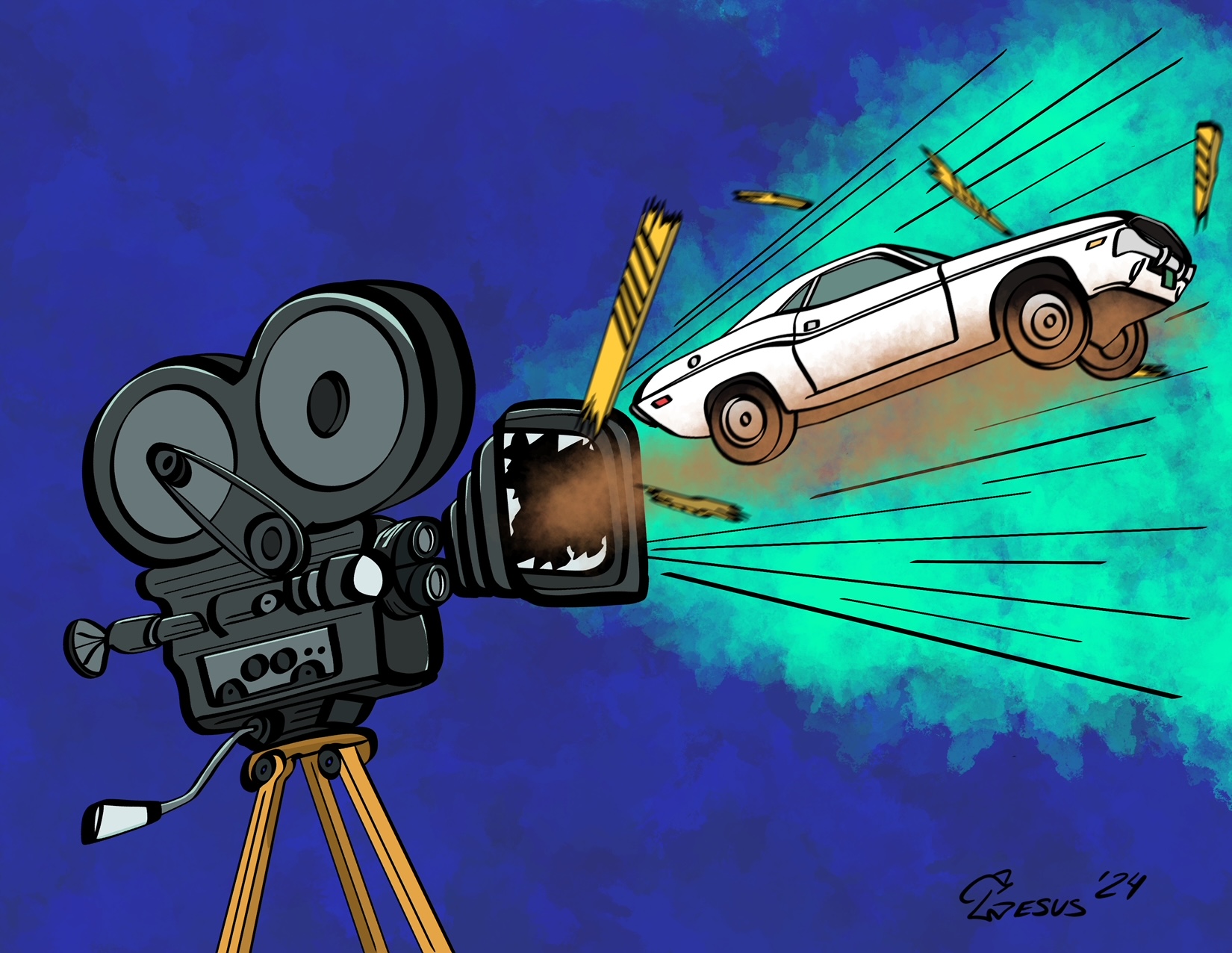In the Year 1971
Those conscious in 1971 longed for escapism to exhale from the turmoil of witnessing two public political assassinations, a man walking on the moon, and watching the Vietnam War conflict broadcasted on evening news be explained through enemy kill ratios.
The same year Hunter S. Thompson roamed the Nevada desert searching for the American Dream on a handful of LSD and a Mint 400 press pass, the former Senior Editor of Car and Driver, Brock Yates, was racing across the country with his son in the “Cannonball Baker Sea-To-Shining-Sea Memorial Trophy Dash.” Meanwhile, many Americans piled into their big block powered station wagons, or Volkswagen Beetle, and headed to the local drive-in to catch the premiere of one of four films with a motorized cast.
Birth of the Road Movie
1971 should go down in digital history books as the year the Road Movie was born.
It was the year the Detroit horsepower war peaked, as the Big Three shoehorned super-leaded V8s into some of the most desired pieces of sheet metal ever designed. The same year, Hollywood released a handful of movies that would become cult classics in the minds of car fanatics by screening some of the best cinematic car sequences ever filmed.
Vanishing Point (1971)
The first road movie to premiere in 1971 was Vanishing Point, released on March 13. It is the greatest road movie ever. I’ll charge any hill to defend that statement.
Vanishing Point captured the mood felt at the time—exhaustion. A sense of people being tried of the war, social conflicts stained with spilled blood, the economy embodied by Barry Newman’s Kowalski, a decorated Vietnam War veteran, ex-police officer, and former stock car and motorcycle racer whose only job is to deliver a “supercharged” 1970 Dodge Challenger R/T 440 Six Pack from Denver to San Francisco over Easter Sunday weekend.
Burnt out by life, he only wants to live at his own pace – 110 per.
This road trip requires only one travel snack, a pocket full of West Coast turnarounds (methamphetamine) as he sets off late into the night – pistol grip shifter in hand. The movie is one long car chase as Kowalski evades Colorado, Nevada, and California state police using the glory of American V8 muscle. The cops don’t know why he’s running, but they are hell-bent on stopping him – permanently.
“This radio station was named Kowalski in honor of the last American hero to whom speed means freedom of the soul. The question is not when’s he gonna stop, but who is gonna stop him.”
– Super Soul, Vanishing Point (1971)
Coincidentally, the spring of ’71 ended with a five-day demonstration by the Vietnam Veterans Against the War on April 23, 1971. The week-long protest saw an estimated 1,000 veterans throw their medals and ribbons on the Capitol steps in Washington, D.C., denouncing the war.
Le Mans (1971)
The summer of ’71 began with the premiere of Le Mans on June 23, 1971. The film starred Steve McQueen as Michael Delaney, a speed-addicted racing driver for the Gulf Porsche Le Mans racing team. Le Mans was filmed using real race cars captured at real speed, edited with actual racing footage from the previous year’s 24 hours of Le Mans race to create some of the most visually harrowing racing and crashing scenes from an era of practical stunts, heavy-mounted cameras, and guts made of solid brass.
“When you’re racing, it’s life. Anything that happens before or after is just waiting.” – Steve McQueen, Le Mans (1971)
Before the film’s release, Steve McQueen competed in the 12 Hours of Sebring race in 1970, driving a Porsche 908/2 with Peter Revson. McQueen ended up winning the three-liter class with a cast on his left leg from a previous motorcycle accident.
Naturally, he wanted to chase this high to a more significant race, the 24 Hours of Le Mans, driving the insanely fast Porsche 917K. However, the movie studio did not want to risk their big name actor and forbade McQueen from entering the race. So, a compromise was settled that allowed McQueen to go full-send in a Gulf Porsche 917 at Le Mans for the film instead of the actual race. Speed is speed.
Two Lane Blacktop (1971)
The following month, people crowded around the big screen to watch the premiere of Two Lane Blacktop on July 7, 1971. Another road movie with a primarily silent anti-hero-type piloting a high-caliper V8 across the country for no real reason other than it’s something worth doing. This film stars James Taylor as The Driver and The Beach Boys’ Dennis Wilson as The Mechanic riding in a primer black 1955 Chevrolet 150 two-door post powered by a far-from-stock 454 big block V8.
“Just color me gone, baby!” – Warren Oats, Two Lane Blacktop (1971)
Traveling the road as highway drifters, they pick up The Girl, played by Lauren Bird, and run across GTO, played by Warren Oats, another mile marker nomad driving an Orbit Orange 1970 Pontiac GTO Judge.
There’s a scene in the movie where The Driver and GTO agree to race across the country to Washington, D.C., for pink slips. However, that plot device is abandoned by the end of the movie. This is another road movie that doesn’t emphasize a destination. The journey is the goal, representing freedom of expression to roam regardless of whether it’s running away or simply trying to get away.
Honorable Mention, The French Connection (1971)
The French Connection premiered on October 9, 1971. While this Academy Award-winning neo-noir crime thriller is far from a road movie, it deserves an honorable mention for its car chase sequence. The heart pounding chase was filmed guerilla style with little to no permits or supervision.
The fast-paced scenes were done with stunt driver/actor Bill Hickman at the wheel of a Pontiac LeMans and director William Friedkin sitting in the back seat, holding the camera steady as they torpedoed through New York City traffic at 70 mph to get the shots they needed for the movie.
One iconic scene showed the Pontiac sedan getting T-boned by a passing Ford sedan at an intersection. This scene wasn’t scripted or planned. It was a real accident, with Gene Hackman behind the wheel, taking the hit and totaling the Pontiac.
Fun Fact: The Police Motor Pool mechanic Irving Abrahams, who helps dismantle Frog One’s Lincoln Continental in the garage in search of the heroin, wasn’t an actor. Abrahams was the real NYPD mechanic who helped the real detectives Eddie Egan and Sonny Grosso crack the “French Connection” case the film is based on.
Duel (1971)
By November 1971, Brock Yates and Dan Gurney had made history driving a Ferrari Daytona from New York to California in 35 hours and 54 minutes. The same month, a made-for-TV movie directed by a young unknown director named Steven Spielberg premiered on the ABC Movie of the Week on November 13, 1971.
The film was called Duel, and it starred Dennis Weaver driving an orange 1970 Plymouth Valiant being terrorized by a faceless, nameless homicidal truck driver in an oily patina 1961 Peterbilt 351 tanker truck. In keeping with the pattern of road movies from this year, the plot is paper thin, with no clear destination, only the journey, which, in this case, is a deadly game of cat and mouse brought on by a moment of road rage.
“Come on, you miserable fat-head, get that fat-ass truck outta my way.” Dennis Weaver, Duel (1971)
Spielberg cuts his teeth with this film using camera movements that would become his signature. This takes the viewer on an anxious, suspenseful rollercoaster ride as we’re placed in the shoes and mind of Weaver’s everyman character of an average man pushed into an extraordinary situation. The orange Plymouth plays David against the diesel-burning Goliath in a battle that ends in a spectacular ending fight.
The Calm Before the Storm
1971 was a great year to be a car fanatic. You could keep a thirsty V8 running and humming at 36 cents a gallon and strut down the main street drag listening to Casey Kasem’s American Top 40 on the radio. Blissfully unaware of the looming storm over the horizon that would ruin the party by 1973 with the oil embargo, slapped with the national 55 mph speed limit in 1974, which would last through all of Generation X and into the Millennial birthdays of 1995.
Nevertheless, these road movies carved a niche in the cinematic landscape. It paved the way for movie producers and studio executives to green light a seemingly endless run of road movies with a mixed bag of fantastic car stunts and cringe worthy acting like Dirty Mary and Crazy Larry (1974), Thunderbolt and Lightfoot (1974), Gone in 60 Seconds (1974), Cannonball (1976), The Gumball Rally (1976), Eat My Dust (1976), Grand Theft Auto (1977), Speedtrap (1977), Smokey and the Bandit (1977), and Convoy (1978) – to name a few.
This includes maverick short films like Claude Lelouch’s masterpiece C’était un Rendez-vous (1976), which continues to inspire filmmakers today with its ultra-realism style. This zero-fat, single-take short film puts the viewer at the very edge, riding the front bumper of a speeding car across the center of Paris.
So, if you appreciate all things fast and on wheels, you owe it to yourself to check out these films and pay respects to the directors and stunt coordinators who made them possible.






Comments
Loading comments...
Failed to load comments. Please try again later.
Leave a Comment